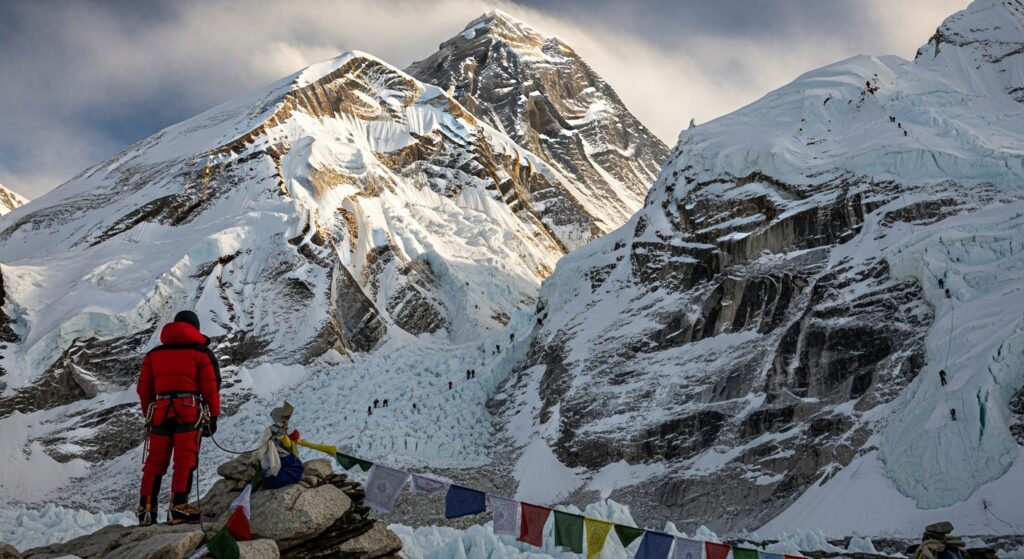Mount Everest, the tallest mountain on Earth at 8,848 meters (29,029 feet), has long captivated adventurers, climbers, and explorers. While most are familiar with the South Col route in Nepal, the North Face of Mount Everest in Tibet presents an equally formidable and historically significant challenge.
The North Face is known for its treacherous terrain, extreme weather conditions, and technical climbing demands. Unlike the more popular southern route, the northern side offers a raw and rugged experience that tests climbers’ endurance, skill, and resilience. In this article, we will explore the history, routes, challenges, and modern significance of the North Face of Mount Everest.
History of the North Face of Mount Everest
The North Face has played a pivotal role in the history of mountaineering. Early expeditions in the 1920s and 1930s focused on the northern approach due to political and geographic reasons:
-
1921 British Reconnaissance Expedition: The first survey of Everest included the North Face, establishing potential climbing routes.
-
1924 Mallory and Irvine Expedition: George Mallory and Andrew Irvine attempted the summit from the North Face. Their fate remains one of mountaineering’s greatest mysteries.
-
1953 South Col Success: While Sir Edmund Hillary and Tenzing Norgay conquered Everest from the south, the North Face continued to attract climbers seeking a greater technical challenge.
The North Face became known as the route for experienced mountaineers seeking a more difficult ascent, requiring skill in ice climbing, mixed terrain, and high-altitude survival.
Geography of the North Face
The North Face of Mount Everest rises steeply above the Tibetan Plateau, presenting a landscape of glaciers, icefalls, and rock faces. Key features include:
-
The Rongbuk Glacier: Provides access to the North Base Camp, serving as the starting point for northern ascents.
-
The Second Step: A 40-meter vertical rock face at 8,600 meters, considered one of the most challenging parts of the route.
-
Hornbein Couloir: A narrow, steep gully that demands technical expertise and careful navigation.
-
Extreme Altitude Conditions: Climbers face oxygen scarcity, strong winds, and severe cold, often exceeding -30°C (-22°F).
The North Face is not only a test of physical endurance but also a strategic challenge, requiring meticulous planning and acclimatization.
Climbing Routes on the North Face of Mount Everest
Several routes traverse the North Face, each offering unique challenges:
1. North Col Route
-
Begins at the North Base Camp.
-
Climbers ascend the North Col (7,020 meters) before tackling the summit ridge.
-
Features steep snow slopes, icy terrain, and high-altitude camps.
2. Hornbein Couloir Route
-
Known for its steep, technical rock and ice climbing.
-
Often used by elite climbers seeking a more direct and challenging ascent.
-
Requires expert navigation, specialized gear, and extreme physical fitness.
3. Norton Couloir Route
-
Rarely attempted due to technical difficulty and risk of avalanches.
-
Offers an alternative route for experienced alpinists.
Each route on the North Face demands careful preparation, acclimatization, and respect for the unpredictable Himalayan weather.
Challenges of Climbing the North Face
Climbing the North Face of Mount Everest is not for the faint of heart. Key challenges include:
-
Extreme Weather: Sudden storms, high winds, and sub-zero temperatures make the ascent perilous.
-
Altitude Sickness: Reduced oxygen levels at extreme heights pose serious health risks.
-
Technical Terrain: Icefalls, rock faces, and steep couloirs require advanced climbing skills.
-
Limited Support: Fewer commercial expeditions compared to the South Col route, meaning climbers must rely more on personal skill and team coordination.
-
Psychological Stress: Long, exhausting climbs and isolation test mental resilience.
These factors make the North Face a true benchmark for elite mountaineers seeking to push their limits.
Modern Expeditions and Achievements
Despite its challenges, the North Face continues to attract adventurers worldwide:
-
1990s Onward: Advances in climbing technology, oxygen systems, and weather forecasting improved safety and success rates.
-
Record Climbs: Elite mountaineers have completed rapid ascents via the North Face, demonstrating human endurance and technical skill.
-
Winter Ascents: Few climbers have tackled the North Face in winter, highlighting the extreme difficulty and danger of this route.
-
Solo Climbs: Some mountaineers attempt solo ascents, underscoring the combination of courage and preparation required.
Modern expeditions combine traditional climbing skills with innovative technology to navigate this formidable terrain.
Safety Measures and Preparation
Climbing the North Face requires meticulous preparation:
-
Physical Training: Cardiovascular endurance, strength, and high-altitude acclimatization.
-
Technical Skills: Ice climbing, rope handling, and survival skills in extreme conditions.
-
Gear: High-quality mountaineering boots, crampons, ice axes, oxygen systems, and layered clothing.
-
Route Planning: Understanding weather patterns, avalanche risks, and emergency evacuation protocols.
-
Team Coordination: Collaboration with guides, sherpas, and fellow climbers is essential for safety and success.
Proper preparation significantly increases the likelihood of a successful and safe ascent.
Environmental Considerations
Climbing Everest, including the North Face, has environmental implications:
-
Waste Management: Mountaineers must manage human and equipment waste responsibly.
-
Glacier Preservation: Careful route planning helps reduce the impact on fragile glaciers.
-
Eco-Friendly Expeditions: Increasing awareness has led to sustainable expedition practices and reduced carbon footprints.
Maintaining the natural integrity of the North Face is critical to ensuring future generations can experience this extraordinary landscape.
Looking Ahead: The Future of North Face Expeditions
The future of climbing the North Face of Mount Everest is likely to be shaped by technology, sustainability, and safety innovations:
-
Advanced Gear: Lighter, stronger equipment to enhance climber performance and reduce risk.
-
AI Weather Forecasting: Predicting storms and avalanche risks with greater precision.
-
Sustainable Expeditions: Minimizing environmental impact through responsible practices.
-
Virtual Training: Simulated climbs to improve preparation and reduce unnecessary exposure to risk.
-
Scientific Research: Using expeditions to study climate change, glacial melting, and high-altitude physiology.
As mountaineering evolves, climbers will continue to challenge themselves while prioritizing safety and environmental stewardship.
Conclusion
The North Face of Mount Everest is more than just a climbing route—it is a symbol of human courage, endurance, and ambition. With its steep terrain, extreme weather, and technical challenges, it represents one of the ultimate tests for mountaineers worldwide.
From early 20th-century explorations to modern expeditions, the North Face has shaped the history of high-altitude climbing. It demands physical fitness, mental resilience, and meticulous planning, making it a true benchmark of mountaineering excellence.
As we look ahead, the North Face will continue to inspire adventurers while emphasizing the importance of safety, preparation, and environmental responsibility. For those who dare to take on its challenges, the North Face of Mount Everest offers not only a summit but also an unparalleled experience of human achievement and natural wonder.






